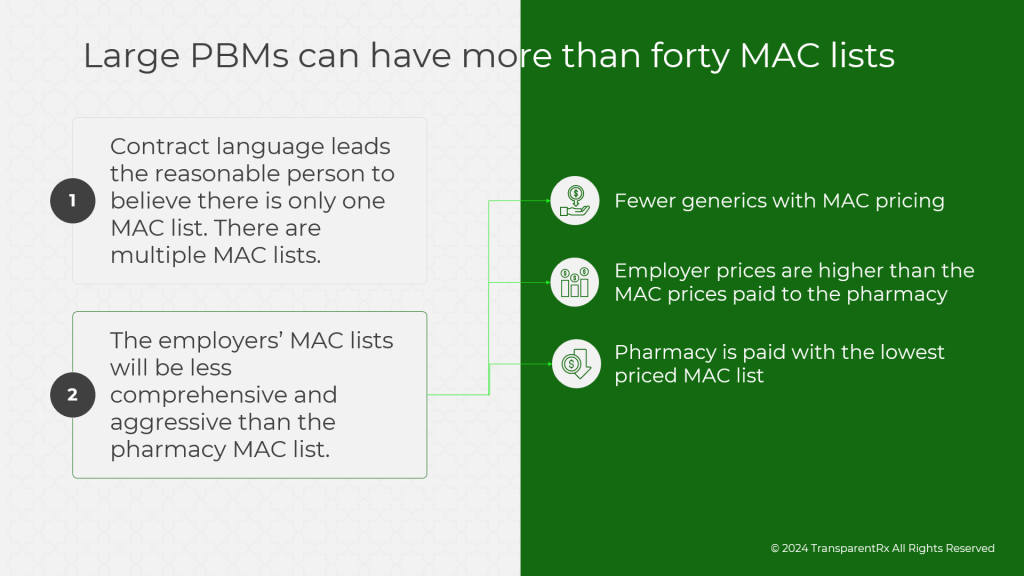When managing pharmacy benefits, one of the least transparent practices utilized by many Pharmacy Benefit Managers (PBMs) is the use of multiple Maximum Allowable Cost (MAC) lists. This tactic, while complex, can significantly affect plan sponsors, especially Benefit Directors, employee benefit brokers, and PBM consultants, by inflating costs and undermining transparency.
What are MAC Lists?
A MAC list is a pricing benchmark used by PBMs to determine the maximum amount a plan will pay for generic drugs and in some cases multisource brand drugs. Ideally, a single, well-structured MAC list should set a consistent reimbursement rate, ensuring fair pricing across pharmacies. However, some PBMs use multiple MAC lists, which is where the problem begins.
The Downside of Multiple MAC Lists
When PBMs deploy multiple MAC lists, each pharmacy or pharmacy network may be reimbursed differently for dispensing the same drug. For example, chain pharmacies might receive higher reimbursements than independent pharmacies for the same generic drug, despite all pharmacies purchasing from similar wholesalers.
A real-world example that illustrates this disparity comes from a recent audit of Mississippi’s commercial prescription drug claims for the calendar year 2022. The audit revealed that a large PBM used 49 distinct MAC lists, with specific lists exclusively applied to chain or independent pharmacies. On average, independent pharmacies were reimbursed 74% less than chain pharmacies for the same drugs. This discrepancy highlights how PBMs manipulate MAC lists to inflate costs for plan sponsors while benefiting select pharmacies.
For Benefit Directors and PBM consultants, the practice of using multiple MAC lists means that PBMs have more room to game the system. Costs that appear controlled on paper may actually be much higher due to varying reimbursement rates. Furthermore, this approach allows PBMs to mask their true margins, making it difficult for plan sponsors to understand where their money is going.

Increased Costs and Lack of Transparency
One of the most significant issues with multiple MAC lists is the lack of transparency. Each list is proprietary, meaning plan sponsors have no way of verifying how much pharmacies are reimbursed or comparing costs across networks. As a result, plan sponsors can find themselves paying more for generic drugs without realizing it, especially if their PBM reimburses affiliate or chain pharmacies at higher rates than independents, as demonstrated in the Mississippi Board of Pharmacy audit.
For example, in the same audit, generic azithromycin was reimbursed at vastly different rates: one independent pharmacy was reimbursed at only 122% of the lowest chain pharmacy reimbursement, while an affiliate pharmacy received 833.3%. These hidden costs accumulate over time, leading to higher overall drug spend, which is then passed on to the plan sponsor.
The Fiduciary PBM Model: A Transparent Alternative
In contrast to this opaque practice, a fiduciary PBM model ensures that the PBM is aligned with the client’s best interests. A fiduciary PBM operates under a legal obligation to manage costs and prioritize transparency. There are no hidden markups, and reimbursement rates are consistent across all pharmacy networks, ensuring that plan sponsors can trust that the lowest price is always being paid for a given drug.
How Fiduciary PBMs Keep Costs Down
- One Transparent MAC List: Fiduciary PBMs utilize a single, transparent MAC list, applying uniform rates across all pharmacies, which eliminates the possibility of hidden profit margins through inflated reimbursement rates.
- Accountability: By adhering to a fiduciary standard, these PBMs must disclose any conflicts of interest and ensure that they do not profit at the client’s expense.
- Cost Control: With the fiduciary model, PBMs are incentivized to actively control drug costs and improve outcomes rather than focusing on maximizing their own margins. This leads to more predictable and often lower drug spend for employers.
Conclusion
For Benefit Directors, employee benefit brokers, and PBM consultants, the use of multiple MAC lists by traditional PBMs presents a significant risk in terms of increased costs and lack of transparency. In contrast, the fiduciary PBM model offers a clear path to managing pharmacy benefits with alignment, cost control, and accountability. By choosing a fiduciary PBM, plan sponsors can ensure that they are paying fair and consistent prices for medications, ultimately protecting their bottom line.
The key takeaway here is clear: when evaluating PBM options, understanding the intricacies of MAC list usage can be the difference between controlling costs or unknowingly inflating them.
